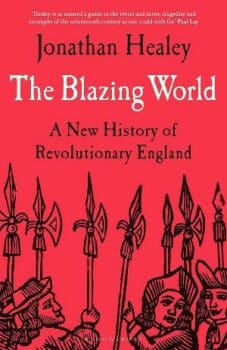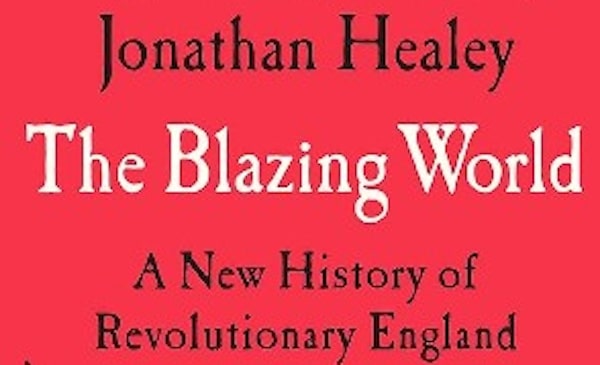
Jonathan Healey, The Blazing World: A New History of Revolutionary England (Bloomsbury 2023), 512pp.
The seventeenth century is witnessing somewhat of a renaissance in popular interest and Jonathan Healey’s The Blazing World provides a sparkling account of the century. Written with quick wit and an eye to the present, Healey argues that the seventeenth century was revolutionary in transforming England society, if only gradually. By the end of the period, government was said to have resembled a situation closer to Elizabeth II than Elizabeth I. Perhaps there is an element of Whiggish progressivism here, but Healey’s narration is a fine synthesis of the period with sound analytical judgement, based on in-depth academic research. It’s written in a lively and engaging tone which makes for a gripping read.
Healey presents early-seventeenth-century England as highly fractured. Changing socio-economic conditions, a rising gentry and middling sort that was becoming increasingly politicised, religious polarisation tied to Puritan moralising reform and anti-Puritans attached to traditional culture (one would be forgiven for seeing the parallel with contemporary culture wars), debates over the nature of sovereignty and an increasingly litigious society. Civil war was not inevitable, but as one leading historian argued, it was made possible by these conflicting views over politics, religion and society.
Healey’s coverage is vast. He provides a whistlestop tour of various facets of English society: law, print, migration, witchcraft, moral reform, radicalism and so forth. While coverage of Scotland and Ireland is thinner, Healey has ensured this is not merely a straightforward narrative of high politics or events in London. Crucially the individual experiences of ordinary men and women, and the engrossing political affairs at Whitehall and Westminster are properly contextualized within the wider political, social and religious conditions that gripped seventeenth-century society.
Crisis under Charles I
The early years of Charles I’s reign would be marked by one crisis after another. Intransigent parliaments were unwilling to provide necessary financial supply, and sought to curtail the monarch’s absolutist tendencies. This was not helped by his embarrassingly disastrous foreign policy, his unpopular favourite, and further religious polarisation as the King’s preference for Arminianism, which to Puritan observers was considered too close to Popish superstition, became increasingly clear. A political showdown would ensue in the Parliament of 1629, where the speaker of the commons was held down in his seat, by MPs opposed to the king, so that three resolutions could be issued against Arminian innovations, and the collection of tonnage and poundage, which had not been agreed by parliament. Charles’ dissolution of parliament in response would lead to his infamous personal rule.
It could be said that Healey somewhat overstates the relative calm of the 1630s, but it is undoubtedly true that the King was able to establish a measure of stability as he got control of his coffers and brought wars on the continent to the end. The year 1637 would prove to be a turning point, as the King sought to impose his conservative Laudian religious settlement on the Scots who rebelled, while domestic opposition to the crown’s financial and religious policies mounted. With the war against the Scots going badly, the period of personal rule was brought to an abrupt halt in 1640, as Charles was once again forced to turn to parliament to raise money.
A core strength is Healey’s ability to bring to the fore the experiences of ordinary people. The book brings to life a number of seldom-told stories such as the amusing mock wedding of Jane Thornborough’s two Catholic servants, which mocked the solemn Protestants celebrations that took place on St James Feast Day, a year on after the coronation of King James I. Other neglected figures, such as the slippery journalist Marchamont Nedham, that are usually missing in more general histories of the period, are also brought to light. More importantly, he emphasises the central role those ordinary men and woman played in shaping the course of political events and driving radical change. Thus, the London crowd is granted significant coverage during the political crisis of 1640 to 1642 that would ultimately lead to civil war through their support of the radical MPs at crucial junctures, notably around the execution of Charles I’s leading minister, the Earl of Strafford in May 1641, and in mounting opposition against the episcopacy in the winter of the same year.
Revolutionary energies unbound
As a result of the breakdown of state mechanisms such as censorship, religious courts and the episcopal hierarchies during the early 1640s, there was an explosion of dissent, of political and religious radicalism, which began to disseminate into mainstream political cultures and receive wider acceptance as the war went on, and as a political settlement failed to be reached. The 1640s was a period of turmoil and dramatic change which caused people to come up with innovative radical solutions to deal with the extraordinary events that faced them. Traditional institutions, systems, beliefs were all up for question and debate.
As the notable Marxist historian Christopher Hill asserted, this was period of great political and intellectual excitement, a period where the old world could be transformed. And these political and religious ideas would emerge from across the social spectrum, including those usually excluded from formal politics. Likewise, the revolution opened up new vistas of political participation. Mass petitioning, lobbying and popular demonstrations would become increasingly commonplace.
From more familiar political groups like the Levellers, who advocated for popular sovereignty, and the Diggers, who called for the common ownership of land, to the emergence of new religious groups such as Baptists and Quakers as religious toleration was extended, Healey does a fine job in charting the path of the different radical strands and, although Marxists may not agree with Healey’s conceptualisation of the revolution, he convincingly demonstrates the revolutionary nature of the mid-seventeenth century. For Healey, the story of the English revolution, which culminated in the execution of Charles I in 1649 and the establishment of the Republic, was that the nation’s ruler was accountable to their people. It would also be important to stress the important legacies left behind by the practices and ideals associated with the English revolution which would prove to be central to liberalism, socialism and the English radical dissenting tradition more broadly.
The 1650s is still sometimes regarded as a bugbear for progressives and conservatives alike. For the former, it is viewed as a betrayal of the Revolution, while the latter would rather forget the period where England was not governed by a monarch. Healey provides extensive coverage of the period, but he too characterises the period as one of a gradual trek back towards a monarchical restoration. It is true, as Healey suggests, that the republic was brought about by a minority, but its ability to govern was reliant on obtaining the co-operation of the wider populace. Recent work on the period has begun to demonstrate the extent to which individuals were accommodating themselves to the Republic. The Rump Parliament (1649-1653) dealt with its domestic and foreign threats with relative success and the establishment of the Cromwellian Protectorate in December 1653 seemed to have brought about some much-needed political stability. On the death of Oliver Cromwell in September 1658, his son Richard would accede as Lord Protector with little sign of opposition, and Royalists would spend the next few months lamenting what they believed to be the hopelessness of a restoration of Charles Stuart. It is somewhat of a shame then that Richard’s Protectorate is only granted a couple of pages and the Restoration is regarded as a foregone conclusion. Nevertheless, Healey does successfully capture the religious diversity and intellectual creativity of what remains as England’s only republican experiment.
Given how much there is to cover over the seventeenth century, it is only natural that some periods are favoured more than others. Thus, the reigns of Charles II and James II are dealt with in less detail and key moments like the fall of Charles II’s chancellor, the Earl of Clarendon are omitted. However, the key strength lies in Healey’s ability to demonstrate that the Restoration did not mark a watershed moment, nor did it turn the clock back to 1641. The dissenting tradition remained a central feature of English religious and political culture, constitutional issues remained unsolved until the Glorious Revolution of 1688, and the popular political culture that had emerged during the English Revolution was here to stay.
It is well known that Tony Benn was a great admirer of the seventeenth century, drawn to the ideals and values espoused by radical groups of the English Revolution. It informed his politics. There was a moment in the second half of the twentieth century where, historiographically, the mid-seventeenth century was stripped of its revolutionary credentials. That moment has passed, and with the recent interest in the seventeenth century, it is a perfect time for those on the left to once again discover or rediscover England’s radical past. The Blazing World successfully captures the sheer excitement and possibilities of what was, or could have been, and is a great place to start.
Waseem Ahmed is a third year History PhD student at University College London working on a thesis entitled Everyday Politics in Revolutionary England, 1649-1660.

